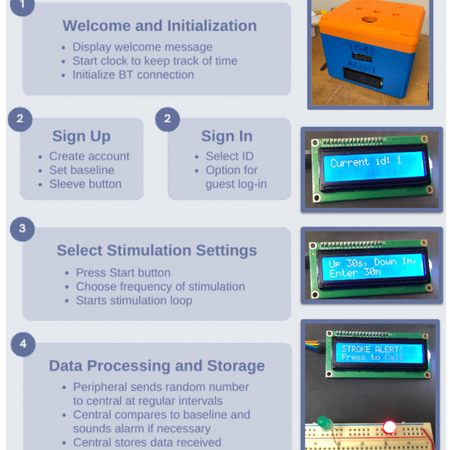
Stroke Overnight Wearable Monitor
Unfortunately, many people suffer severe complications from delayed response to stroke, especially the incidents happening overnight. There are not many very good solutions in the market for this, so this is our project to address this in conjunction with Duke Hospital.
Team:
This is us in our first zoom call together! Fantastic team!
Background: Clinicians and engineers in the Duke Health System noticed a gap in the market for an effective overnight stroke monitor, which can speed up the response for a patient having a stroke. Therefore, they asked us, a group of engineering students, to design, over a period of 5 months, a wearable capable of detecting a stroke overnight and, if so, alert the patient's caregivers.
Overview: There are many ways to detect stroke, especially depending on what causes the stroke. We had many potential approaches, from using EEG, to EMG, to tracking biomarkers. However, after conversing with our clients and professors, we decided to prototype using a simpler approach.
Since many stroke episodes cause one-sided weakness in the body and our research has shown that the Nerve Conduction Velocity (NCV) can be a quantitative way to detect arm weakness. However, since there is not enough research on quantitative analysis about the moment a stroke happens, the main goal for this device is to be both a tool to further understand the relationship of NCV and stroke, as well as the backbone for a commercial overnight stroke monitor.
Due to the limitations in time and resource, we were advised by our professors to build a 2-part system that could be later be integrated. One part is the electric stimulator that measures NCV values, and sends via bluetooth to the other part, which consists of an alarm system that compares the values and alarms the patient's caregivers if there is a stroke. Below is a summary of our process.
Award: Faculty Awards - 2nd place, among all of the BME design teams (total of 18 teams).
Specifications:
My Responsabilities:
Research about stroke and its possible causes and symptoms.
Facilitate communication between our clients and our group.
Brainstorm and design our whole 2-part system.
Design and develop the whole alarm system.
Participate in testing to verify system quality.
Brainstorming:
A combination of all of our ideas during ideation phase:
Our top three ideas from it:
Results:
The alarm system was my primary focus and work, and involved many parts of the design. Its general user workflow was as follows:
The main parts were:
The circutry was designed as follows, for the clock node:
For the arm node:
During our prototyping phase, we decided to transition to using a Nordic nRF52833-DK as our microcontroller due to its low power consumption and industry standard, however due to limitations in time, we had to go with our backup plan of using an Arduino which is a platform we have worked more with. However, I was able to get one of these boards, and I have since then studied and researched more about it, and I am excited to use it in future projects.
The software architecture was designed as follows:
Takeaway: It was a great honor to work in a project in partnership with the Duke Hospital and learn from many experts in the field. I am very proud of the team and our work. The alarm system was a dear project to me, because I was the team member responsible for designing it but I faced many challenges in making it work. But after a lot of hard work and many failures, I am very proud of what we were able to do. I still wish we had more time to design a PCB, refine the enclosure and the system, but it was a great project.
Project Gallery
















